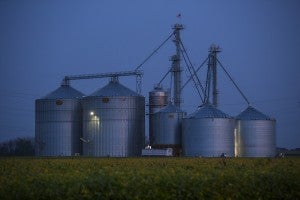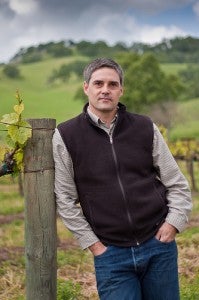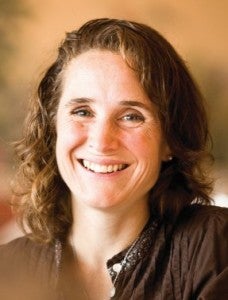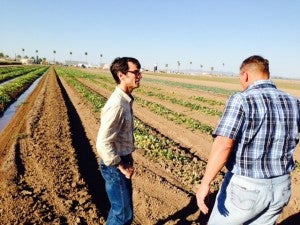 In 2015, U.S. agriculture proved to be a willing and powerful partner in the path to sustainability. We’ve seen farmers, ranchers and food companies make major headway in reducing greenhouse gas emissions, improving soil health, restoring habitat for at-risk wildlife and protecting freshwater supplies.
In 2015, U.S. agriculture proved to be a willing and powerful partner in the path to sustainability. We’ve seen farmers, ranchers and food companies make major headway in reducing greenhouse gas emissions, improving soil health, restoring habitat for at-risk wildlife and protecting freshwater supplies.
Here are some of this year’s highlights:
- Approval of the first carbon offset protocol for crops in a cap-and-trade market (for U.S. rice growers), followed by approval of a grasslands protocol and a huge investment from USDA to develop a fertilizer protocol. These protocols reward farmers for conservation measures that reduce emissions and offer businesses new opportunities to offset the environmental impacts from their operations.
- Launch of the innovative SUSTAIN platform throughout the United Suppliers agricultural retailer network. SUSTAIN, developed in coordination with EDF, trains ag retailers in best practices for sustainable farming and aims to enroll 10 million acres in the program by 2020. So far, over 300 sales representatives in Iowa, Illinois, Wisconsin, Minnesota, South Dakota, Nebraska, Kansas, and Ohio have attended training. And food companies interested in making SUSTAIN a feature of their sustainable sourcing work include Campbell’s, Unilever, Kellogg’s, General Mills, and Smithfield.
- A “not warranted” listing decision for sage-grouse under the Endangered Species Act, due in large part to ranchers’ commitments to develop and implement conservation solutions for the bird. Habitat exchanges – a solution developed by EDF and partners in agriculture and industry – are now available in Colorado, Nevada and Wyoming for landowners to earn new revenue for protecting and enhancing greater sage-grouse habitat.
- Release of Colorado’s first-ever water plan to ensure the health and vitality of the state’s streams, rivers, communities and wildlife – without harming farmers. The plan addresses development of financial mechanisms to incentivize participation in alternative water transfer mechanisms and subsidize agricultural water system optimization. This innovative water planning can now be a model for other water-stressed communities.
So what lies ahead for 2016? We asked our experts to share their thoughts and wishes for the New Year.
Reducing habitat loss

Read Eric’s latest blog about new market opportunities for ag.
From Eric Holst, associate vice president of working lands:
- Aside from another championship for the Golden State Warriors, I’m excited about the potential to put the monarch butterfly back on a path to recovery in 2016. Populations have declined 90% over the last 20 years – and the possibility of listing the species under the Endangered Species Act would indicate massive failure on the part of the conservation community to stimulate action. 2016 is the year to bend the curve back to recovery by tapping into the potential of agricultural lands to provide needed milkweed and wildflower habitat for this iconic American species.
- In addition to launching a habitat exchange program for the monarch butterfly in 2016, I look forward to seeing exchanges formally launch in Colorado, Nevada and Wyoming for the greater sage-grouse, and in California’s Central Valley for multiple species, including Swainson’s hawk, Chinook salmon and riparian songbirds. With the launch of these markets will come numerous opportunities for farmers and ranchers to earn new revenue for conserving wildlife habitat.
Eliminating fertilizer pollution

Learn more about Suzy.
From Suzy Friedman, director of agricultural sustainability:
- In 2016 I want to get the SUSTAIN platform 30 percent of the way towards our enrollment goal of 10 million acres. I also want to replicate sustainability programming across the ag retail sector, with strong support from food companies. Bringing the SUSTAIN model to scale holds huge potential for sustainable ag.
- One of the things I’m most looking forward to seeing on the ground in 2016 is a race to the top for nutrient management tools that help farmers be more efficient and sustainable. Keep an eye out for a new program to be launched in 2016 that will bring transparency to these tools – so that farmers can have certainty that the products they’re using deliver results. That means saving money and eliminating waste from fertilizer use.
Reducing GHGs from agriculture
From Robert Parkhurst, director of agriculture greenhouse gas markets:

Read Robert Parkhurst’s latest blog on ag’s big data boom.
- I’m excited to work with our new partners in 2016 — ranchers, almond growers and rice farmers. We’ll see carbon credits being generated across these diverse agricultural landscapes, which will benefit growers and the planet.
- With the recent adoption of the rice protocol by the California Air Resources Board, I’m especially excited to witness the sale of the first rice credits to a California company in 2016, verified and regulated under the state’s cap and trade program.
Rebalancing water use
From Kevin Moran, senior director of EDF’s Colorado River program:
- One of the goals I am personally excited about in 2016 is taking a leadership role in getting Arizona and the Imperial Irrigation District to assist in reducing the structural water deficit in the Lower Basin of the Colorado River. It’s been widely known that demand for Colorado River water has exceeded the river’s supply in recent years, so I am hopeful that with Arizona continuing to lead on water, we will catalyze a shift toward demand management in the Lower Basin that promotes flexibility and resilience throughout the entire Colorado River system.
- To achieve this goal, we need to make real progress on piloting agricultural water efficiency practices linked to ecosystem benefits, which EDF is pursuing in partnership with the University of Arizona’s ag extension office and Yuma farmers. Through pilot programs, we will influence how Yuma agriculture invests in water efficiency to advance both sustainable agriculture and ecosystem and water system management benefits.

David Festa (left) meeting with a Yuma farmer to learn more about irrigation efficiency. Read his latest blog: 3 investment ideas to sustain water in the American West.
- In 2016, I would like to see California Governor Jerry Brown and the state legislature unleash the potential for water sharing by blowing up the state’s “paper dams” – a patchwork of outdated laws and regulations that have disproportionately affected disadvantaged communities and the environment during the drought. Agriculture has a big role to play in water sharing. Through a whole host of practices – from efficiency, to fallowing, to crop switching – many farmers could sell 10% to 20% of their water for other uses while improving their bottom-line.
EDF’s agriculture team would like to thank all of the partners – from individual farmers to major food companies – for their help in making U.S. agriculture more sustainable and, ultimately, more prosperous.
More to come in 2016!
Related:
Why the sustainable agriculture glass is half full >>
Why almond lovers can breathe easy again >>
Ag’s big data explosion can benefit the environment too >>









